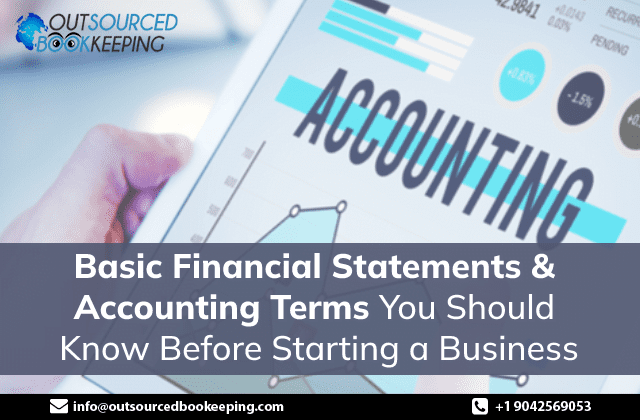A business owner need not have expertise in bookkeeping and accounting but he/she must know enough to swift through these processes. And this know-how should start with understanding the basic accounting aspects and terminology involved in the day to day processes.

However knowing only the accounting terms doesn’t help unless one understands the context and their usage in financial statements, the key statuses report in the finance and accounting world. So the best way forward is to understand the importance of financial statements and then get to know the terms that make them.
If you are a business owner who is on the journey to improve your accounting knowledge then this blog is for you. Here our accounting experts at Outsourced Bookkeeping first help you understand the three core financial statements in the accounting world and then explain the terms in detail for better understanding. Read on:
Three Fundamental Financial Statements Every Business Owner Must Know:
First things first you must know about three essential financial statements that form the foundation of the finance and accounting aspect of a business. By first explaining these three core financial statements we delve into the terms used in them or better understand them. So the three core financial statements for any business are:
1. Income statement: An income statement is a business’s core financial statement that calculates the profit or loss for a specific period of time. An income statement first arrives at net operating income by deducting operating expenses from net sales income. Net sales income can include income from products or services.
Operating expenses can include the cost of sales, marketing, administrative, technology content and fulfilment expenses. The number thus arrives is called net operating income or EBIT (Earnings before interest and taxes). After again deducting tax and other non-operating expenses income statement finally shows the net income or loss.
An income statement is expressed over a specific period of time. Since it assesses the profitability of the business it is often the first statement that is looked up by an analyst or an investor.
2. Cash flow statement: A cash flow statement is a financial statement that gives true pictures of cash equivalents or cash leaving and entering the business. By summarizing the cash inflow and cash outflow of a business cash flow statement helps understand how well a company is equipped in generating cash, funding its current operations while paying its debt obligations. To summarize this, cash flow statements use following components:
Cash from operating activities – Cash generated from sales of product and services form the major share of this component. In addition to this, interest payments, tax payments, salary and wage payments, rent payments may feature in this section.
Cash from investing activities – Cash from any of the company’s investments are featured in this section. This may include the sale or purchase of assets, loans from customers and given to vendors etc.
Cash from financing activities – Cash from banks or investments, payments related to dividends, stock repurchases or debt principal repayment is included in this section.
3. Balance sheet: A balance sheet is a financial document that is generated to summarize the current worth of the company at a given point in time. The balance sheet displays and tallies up all the liabilities, assets and owner’s equity share to correctly summarize the entire worth at a certain date, called reporting date.
As the name suggests the balance sheet must always balance the assets with a combination of liabilities and owner’s equity. The assets and liabilities section include here current assets, non-current assets, current and non-current liabilities, according to our accounting and bookkeeping experts at Outsourced Bookkeeping.
- Assets– Cash equivalents, prepaid expenses, inventory, accounts receivable etc. noncurrent assets include patents, lands trademarks, goodwill, brand, intellectual property and more.
- Liabilities – Payroll expenses, payments like rent and utilities, Accounts Payable, Debt financing and other expenses are featured under current liabilities. Liabilities like loans, leases, bonds payable, tax liabilities (deferred) and pension provisions fall under non-current liabilities.
The residue that is remaining after deducting the liabilities from the assets happens to be the owner’s equity or share holder’s equity. The balance sheet is the crucial financial document that helps us understand the current status of the company. For an internal reviewer, stakeholder or current employee, a balance sheet helps know whether the company is thriving or surviving and gives enough information to make informed decisions to correct or improve the situation. As for an external auditor or investor, it can help identify the investment potential.
Now that you got to know about financial statements and their importance, in our next blog at Outsourced Bookkeeping we delve into accounting and financial terms to help you further improve your knowledge in accounting and bookkeeping. However, if you are equipped with accounting knowledge but are looking for outsourced bookkeeping and accounting services, our accounting experts at Outsourced Bookkeeping can help you. You can contact us here: https://outsourcedbookeeping.com/








